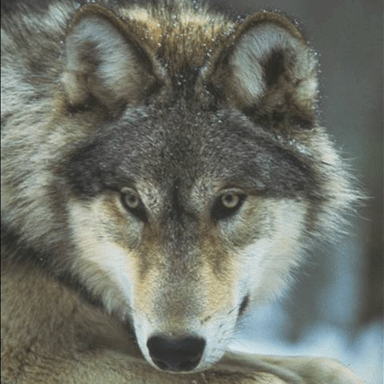
Wolves
Although wolf packs once roamed from the Arctic tundra to Mexico, loss of habitat and extermination programs led to their demise throughout most of the United States by the early 1900s. In 1973, the US Fish and Wildlife Service listed the northern Rocky Mountain wolf (Canis lupus) as an endangered species and designated Greater Yellowstone as one of three recovery areas. From 1995 to 1997, 41 wild wolves from Canada and northwest Montana were released in Yellowstone National Park. As expected, wolves from the growing population dispersed to establish territories outside the Park where they are unprotected from human-caused mortalities. In 2011, the USFWS delisted the wolf from the Endangered Species Act and turned management over to the states. In Montana, the wolf is now hunted and trapped and kept at an artificially low population of 400-600 animals. Livestock ranching is the major cause of wolf deaths due to irresponsible ranching practices and insistence that any wolf sighted near livestock be killed regardless of whether or not the wolf is harming livestock. Learn more here: http://www.nps.gov/yell/learn/nature/wolves.htm
Grizzly Bears
The Greater Yellowstone Ecosystem and northwest Montana are the only areas south of Canada that still has large grizzly bear (Ursus arctos horribilis) populations. Grizzly bears were federally listed in the lower 48 states as a threatened species in 1975 due to unsustainable levels of human-caused mortality, habitat loss, and significant habitat alteration. Human encroachment on bear territory is an excuse for the state and federal government agencies to try to delist grizzly bears prematurely even in the face of clearly declining numbers. The FWS will not release raw data for independent investigation which leads many people to believe they are withholding information because of pressure from interest groups to enact trophy hunting. While the grizzly has ESA protections, so does the land on which she walks. If the grizzly bear is delisted and those protections are lost, 2 million acres of land will become available for energy leases and the “she-bear” will be hunted.
Learn more here: http://www.nps.gov/yell/learn/nature/grizzlybear.htm
Bison
Yellowstone is the only place in the United States where bison (Bison bison) have lived continuously since prehistoric times. Yellowstone bison are exceptional because they comprise the nation’s largest bison population and are the only genetically pure population of bison in the world. Unlike most other herds, this population has thousands of individuals that are allowed to roam relatively freely over the expansive landscape of Yellowstone National Park and some nearby areas of Montana. They also exhibit wild behavior like their ancient ancestors, congregating during the breeding season to compete for mates, as well as migration and exploration that result in the use of new habitat areas. They are continually threatened by the livestock industry because ranchers don’t want bison leaving the Park and eating the grass they believe belongs to “their” cattle. Up to 1,000 bison may be killed in 2016 as they follow their historic migration outside of the Park into Montana.
Learn more here: http://www.nps.gov/yell/learn/nature/bison.htm



